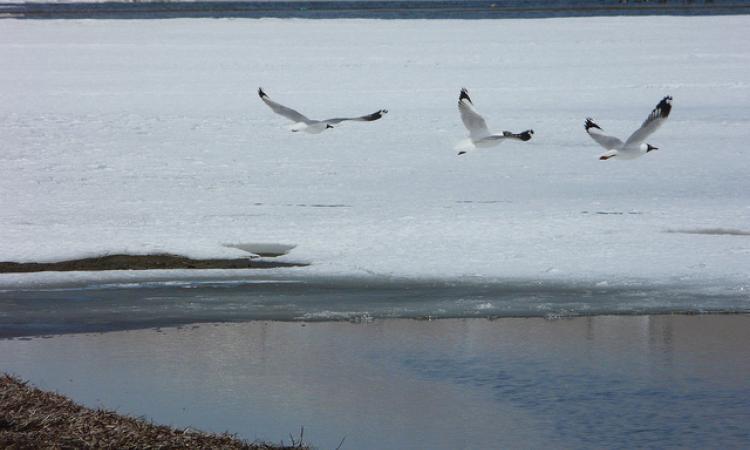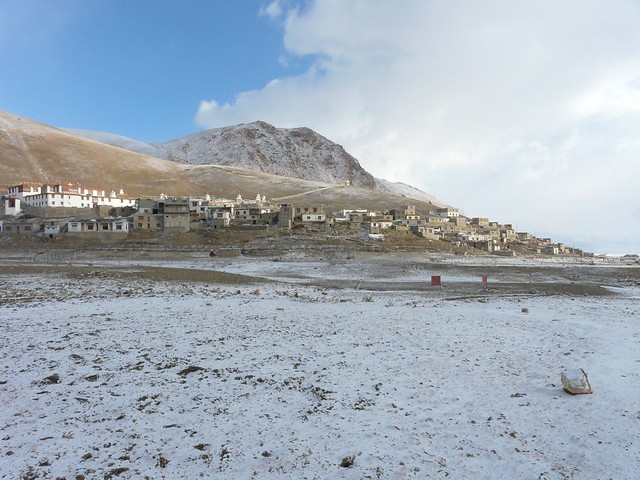
Poised at a breathtaking 4,595 metres above sea level, Tso Moriri is a clear lake fed by multiple springs as well as snowmelt that drains into it from the nearby mountains. Of the streams that feed it, the two primary stream systems lie to the north and the south-west. Tso Moriri once had an outlet that drained water away from it, but it has been blocked for several years now. This has led to the water becoming slightly brackish. It may also have caused the lake to spread into its present size--19km in length and 3km in width.
Two major stream systems that flow into it form wetlands at the points of entry. These, according to Ramsar wetlands, “represent oases of productivity in an otherwise arid steppe environment”. In a cold desert area, they provide valuable vegetative cover for wildlife habitats as well as food for both wildlife and livestock.
Its inhabitants
The livestock here belong to the Chang-pa, a nomadic tribe settled near the banks of Tso Moriri. They practise livestock herding and grow barley in what are reputed to be the highest fields on the planet.
 Tso Moriri is a haven for several species of animals and birds. The primary ones include wild ungulates such as the Tibetan gazelle, great Tibetan sheep and the Tibetan wild ass. Other mammals include Himalayan marmots, three species of mouse hares, hares and voles. The surrounding mountains also host the snow leopard, Tibetan wolf and red fox. The lake is famous for the birds it shelters. Its location makes it an important migratory rest point for an estimated 40 species of birds from six families. The lake is renowned for being the only breeding point in India for the bar-headed goose as well as for the globally threatened black-necked crane.
Tso Moriri is a haven for several species of animals and birds. The primary ones include wild ungulates such as the Tibetan gazelle, great Tibetan sheep and the Tibetan wild ass. Other mammals include Himalayan marmots, three species of mouse hares, hares and voles. The surrounding mountains also host the snow leopard, Tibetan wolf and red fox. The lake is famous for the birds it shelters. Its location makes it an important migratory rest point for an estimated 40 species of birds from six families. The lake is renowned for being the only breeding point in India for the bar-headed goose as well as for the globally threatened black-necked crane.
Providing an opportunity to see rare wildlife by the shores of a crystal-clear lake ringed with snow-clad mountains, Tso Moriri sounds like a traveller's dream.
The lake under threat
Unfortunately, it is precisely this attractive nature that is threatening the lake today. A survey by Birdlife International determined that Tso Moriri is under high threat with human interference leading to moderate to rapid rate of deterioration. When Ladakh first opened its doors to tourism in 1974, 527 people visited the area. Since then, numbers have grown exponentially with nearly two lakh visitors in 2014, which is considerably more than the residential population of 1.33 lakhs. How does this affect the area?
Seema Bhatt, co-author of Ecotourism Development in India which examines the impact of ecotourism in India, says, “Tourism has increased drastically in this area and the numbers have risen from a few hundred to several thousand today. As a consequence, unregulated tourism has emerged as a conservation threat. Tourists who come with their pack animals—donkeys, mules and horses—are putting additional pressure on the already depleting pasture lands. Vehicles that bring tourists are often washed in the lake and connecting streams. Increased human activity disturbs wildlife and also causes degradation of the ecosystem. Camping of visitors close to the breeding sites of several highly endangered species has adversely affected conservation initiatives.”
The tourism season also coincides with the breeding season for waterfowl, threatening the continued survival of these birds. World Wildlife Fund (WWF) India also expresses concern over unethical activities such as jeep safaris chasing animals, off roading, and dumping of garbage down animal burrows. Road construction, largely fuelled by tourism needs, affects animal burrows and damages this fragile ecosystem.
Seeking solutions WWF India has been working on mitigating the impact of tourism in the area with the help of the people of Korzok, the nearest village. The efforts have focused on giving local people control over both the influx of tourists and the income generated by this activity. This has resulted in the establishment of the Tsomoriri Conservation Trust which manages tourism in the area. Presently, scattered camping around the lake is not permitted. This has restricted the camping footprint to a site near Korzok. People have also established homestays for visitors.
WWF India has been working on mitigating the impact of tourism in the area with the help of the people of Korzok, the nearest village. The efforts have focused on giving local people control over both the influx of tourists and the income generated by this activity. This has resulted in the establishment of the Tsomoriri Conservation Trust which manages tourism in the area. Presently, scattered camping around the lake is not permitted. This has restricted the camping footprint to a site near Korzok. People have also established homestays for visitors.
Seema Bhatt cautions that this may not be enough. She says, "While it is difficult to do, it is crucial to conduct an assessment of the carrying capacity of the area. Based on this, the number of tourists needs to be limited. And finally, a very strict code of conduct needs to be established and implemented."
Pankaj Chandan of the WWF's Freshwater and Wetlands Programme says, “There is a need to encourage stakeholders to recognise the importance of management plans and to emphasise to the state and central governments (the need) for provisioning of separate funds for the implementation of these plan.” So far, the latter has not happened in the case of Tso Moriri.
With the Wetlands Policy coming up for review, it remains to be seen if Tso Moriri will continue to host the birth of new generations of bar-headed geese.
/articles/saving-tso-moriri